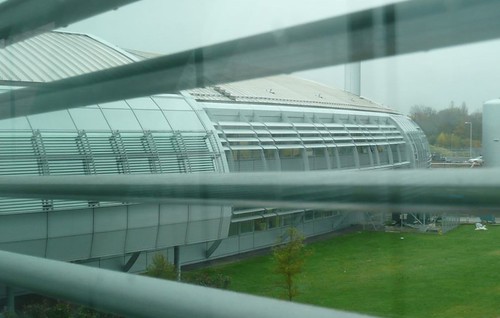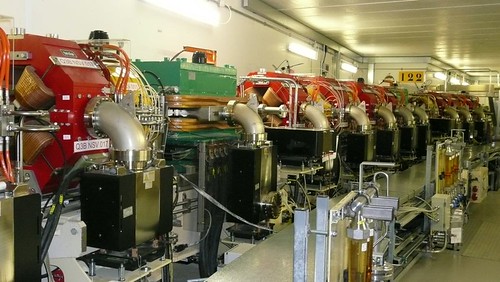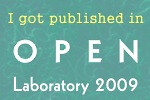On Tuesday, following a tip-off from Maxine, Richard noted the passing of the Daresbury Synchrotron in Cheshire, which shut down finally in August. This gave me pause for quiet reflection since I had been a Daresbury user since 1991, cutting my teeth as a crystallographer by spending long nights in the darkroom developing the film packs that we used to record the X-rays scattered by our crystals.
More often than not we would come away pretty satisfied with the outcome of those long hard nights. Sometimes we had more than 48 hours of beam-time to sweat through and would struggle home with a kind of jet-lag having worked odd hours of the night and day. I remember on one trip (when I was running a group of one – yours truly) working a 48 hr stretch entirely on my own. By that time they had at least made the switch to electronic detectors which you could leave running on automatic for the hours needed to collect the data – so I could get some snatches of sleep.
However, these days the introduction of CCD detectors means that you can grab your data in as little as 30 minutes, so the turnaround time between crystals is much faster and there is little time for a break. That’s assuming that your crystal diffracts X-rays in a nice orderly fashion – more often than not, instead of orderly ranks of spots, you see a few irregular black smudges – and that means only one thing: next crystal please!
So trips to Daresbury were never easy or relaxing – there was plenty that could go wrong, not just with our crystals but also with the machine, which every so often would decide unceremoniously to dump its current of electrons, turning off the X-rays that were probing the innards of our proteins. But along the way we still got plenty of useful data to kickstart quite a few structural projects. We even have a few structures determined using Daresbury data that are still to be published (manuscripts in tardy preparation) – as, I imagine do other groups – so we haven’t yet heard the last of the Daresbury synchrotron.
Yet as Daresbury flickers and fades a new X-ray source has ignited in the middle of the Oxfordshire countryside. The Diamond Light Source is now open for business and, co-incidentally, I was there yesterday helping to chaperone a group of UG and PG students from Imperial who were visiting for the day to discover what a real synchrotron looks and feels like.

Diamond – the donut has landed
Diamond is a truly impressive facility – a massive, gleaming donut of a building. It reminded me of my favorite quotation from Homer Simpson which I have pinched for the title of this piece. It is also the workplace of NN blogger Sara Fletcher with whom I was delighted to catch up yesterday and who will no doubt tell us more about life at Diamond in blogs to come.
The curved experimental hall contains a huge concrete tunnel that houses the accelerator or ‘storage ring’. The ring is basically an evacuated pipe, a few cm in diameter that is surrounded by radiofrequency cavities to keep the electrons whizzing round at close to light speed and magnets to steer them through the ring. Every so often a magnetic insertion device causes the electrons to shimmy as they pass. This electronic wiggle releases a burst of intense X-rays down the beam-line and into the sample – which in our case is a tiny crystal of proteins, often no more that 0.1 mm in size. The beam-lines fan out tangentially from the ring – at present there are about 20 of them.
But I’m getting way too techie. While I wipe the flecks of foam from my mouth it will suffice to say that with Diamond the good work of X-ray analysis initiated at Daresbury will continue. The torch has passed and fortunately is brighter than ever!
Oh, and one more thing. I was pleased to see that the section of the storage ring that we visited was housed in “Zone 13”:
Last week I spent several nights in a hotel that had no room 1013 on the 10th floor, presumably as a sop to the superstitious. It is good to report that no such nonsense is tolerated at Diamond!







Nice post, Stephen. Good to read and see this about Diamond. Did you see that Nature Materials Commentary, Two million hours of science which sparked my then Richard’s post? I really liked that piece. I never worked at Daresbury but I remember a couple of fibre-diffraction visits to DESY in Hamburg; similarly, very little sleep in trying to make the most of our time-slot with the beam.
I confess I had missed your post – too much running around of late – but had caught sight of the Nat Materials article via Richard’s.
I used to feel sorry for the physicists who used Daresbury since they seemed to spend much longer periods at the synchrotron that we fly-by-night protein crystallographers. They would therefore have had to endure much larger doses of the Daresbury catering which, sad to say, was one of the low-lights of the experience. The ESRF food is far superior! Hopefully Diamond will strive for similar standards…
Thanks for that post, Stephen. I feel improved thereby!
Cheers Henry – help yourself to a donut!
mmm doughnuts
Oh all right – you can have one too.
I can has doughnut?
Bought a pack of them for the team this morning so we can all has doughnuts.
Really enjoyed that one, Stephen.
On the 13 business, I was involved in some IT aspects of Terminal 4 at Heathrow, so had a trip round it with some of the designers before it was opened.
The cunning thing they did was to put gates 12 and 14 at opposite ends of the building. That way, you don’t notice there is there is no gate 13, and assume that gate 14 is unlucky because it’s ‘really’ gate 13.
We know people play this silly mental trick because infamously Mahler called his ninth symphony his tenth, because of the tendency of composers to die after writing their ninth. He died after he wrote it…
Glad you liked it Brian.
The to-do over whether or not to use ’13’ is market-driven I guess but has to reflect the superstitious mindset of most of the population. Personally, I have a soft spot for the number since I was born on the 13th.
I do tend to avoid walking under ladders but that’s more of a health and safety issue…!
My younger daughter was born at 2358 on the 12th August. She missed the 13th (I’m not superstitious but I suppose she might have been/might be), but unfortunately it is the start of the grouse shooting season, I’m told. However, she does not move in those circles so I suppose it is all a bit academic. One day, perhaps? (Hope not!)
Coincidentally, 12th August (the Glorious Twelfth) is my wedding anniversary. Our youngest was born late on the 21st June and rejoices in the fact that her birthday is the longest day of the year (in this hemisphere at least).
What a wonderful building – did you take the photos? We are lucky at UKRC to have Sara as our current ‘one-off’ blogger – just till 14 November (have linked from there to here). I am now wondering if a complete non-physicist like myself could ever have a tour. And if some people work in donuts, what am I working in? It is shaped like a custard cream.
Hi Ruth – yes I did take the pictures as we were shown round. I think they are pretty keen on public engagement and may even have open days. Sara may be able to advise on that. It’s definitely worth a look!
Talking of numbers, the Elder Pawn was born on 1st April; the Younger on 5th November. My sister’s birthday is on the 13th of one month; mine the 14th of the following. I deliberately walk under ladders, throw salt on the pavement (when it’s icy) and aim for black cats.
Sorry, only just seen this!
Diamond is a great place to work, it is such an iconic building if nothing else! Although I do find it disturbing seeing my work place every morning on the title sequence of our local BBC news station!
@Ruth – We do have open days, but we are usually overwhelmed with visitors – when we did an open day in 2007 we had 4,000 people visit in one day, and 6,000 people applied for the free tickets.
I think it’s a good sign that people are so interested in us as a scientific facility, the age range for visitors was very broad, as were scientific backgrounds.
Hi Sara – sounds to me that you could probably charge an entry fee and still have people coming…!
@Richard – I deliberately walk under ladders, throw salt on the pavement (when it’s icy) and aim for black cats.
I’m with you on the other two but there is logic in avoiding passing under ladders, especially if there’s a clumsy eejit working above…!
I’m sure we could charge an entry fee for public open days, and for the priviledge of showing groups of undergrads around 🙂
@Stephen, well obviously. That’s why God gave me eyes, to do a risk assessment first.
Just be careful you don’t bump into that ladder while you’re filling out your risk assessment… 😉
And, veering back on topic – ever had cause to use the Austrailian Donut?
‘Oh, it’s working?’
No, I haven’t, but a friend/colleague has. It was good because there was no one there, and bad because there was no one there. But then, it’s Australia.
(Look at that. An entire comment without criticizing your spelling. Oh, damn)